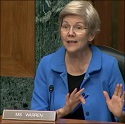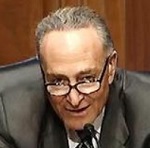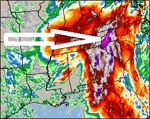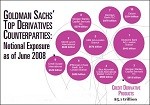-
Recent Posts
- Trump’s “Big Beautiful Bill” Is a Grotesque Giveaway to Fossil Fuel Billionaires While Adding $3.3 Trillion to Nation’s Debt
- Senator Chris Murphy Charges that Trump “Has Opened a Channel for Bribery”
- Congressman Casten: Trump’s Assault on the Rule of Law Is Causing Capital Flight Out of U.S. by Foreign Investors
- Trump’s Approval Rating Drops to 80-Year Low; IMF Says U.S. Tariffs Now Exceed the Highs During the Great Depression
- Nasdaq Has Lost More than 3,000 Points Since Trump’s First Full Day in Office in 2025; the Pain Has Barely Begun
- The Bond Crisis Last Week Was a Global No-Confidence Vote in U. S. President Donald Trump
- Trump’s Tariff Plan Guts $5 Trillion in Stock Value in Two Days; Senator Warren Calls for Emergency Action Before Markets Open on Monday
- Trump’s Attacks on Big Law, Universities, and the Media Have a Common Goal: Silence Dissent Against Authoritarian Rule
- Trump Administration Gives All Clear to Laundering Money through Shell Companies and Bribing Foreign Officials
- Four Megabanks on Wall Street Hold $3.2 Trillion in Uninsured Deposits – Which May Explain Senator Schumer’s Pivot to the GOP to Stop a Government Shutdown
- Here’s What Came Crashing Down Yesterday for Trump’s “Genius” Guy, Elon Musk: Tesla Stock, Access to Twitter (X), His Years of Secret Calls with Putin
- After Banning the Associated Press, Trump Is Now Targeting Specific Journalists That He Wants to See Fired
- Closely Watched Atlanta Fed Model Predicts Negative U.S. Growth in First Quarter
- Trump’s Gangster Diplomacy Makes Front Page Headlines Around the Globe
- Who Benefits Alongside Elon Musk If He Succeeds in Killing the CFPB: the Megabanks on Wall Street that Underwrite His Tesla Stock Offerings
- In Trump 1.0, the State Department Used Taxpayer Money to Publish a Book Elevating Elon Musk to a Superhero; It Was Funded by USAID, the Agency Musk Wants to Quickly Shut Down
- News Host Joy Reid Raises Threat of Trump Selling U.S. to Putin; Ten Days Later Her Show Is Cancelled
- Elon Musk’s DOGE Appears to Be Violating a Court Order; It Has Taken Down Hundreds of YouTube Videos that Educate Americans on How to Avoid Being Swindled
- Barron’s Releases Audio of Jamie Dimon Cursing Out His Workers at a Town Hall, as Dimon Plans to Dump Another One Million JPM Shares
- There’s One Federal Investigative Agency that Neither Trump nor Elon Musk Can Touch: It Just Opened an Investigation into DOGE
- Elon Musk’s Companies Were Under Investigation by Five Inspectors General When the Trump Administration Fired Them and Made Musk the Investigator
- Donald Trump Gives the Greenlight to Goldman Sachs and JPMorgan Chase to Return to Bribing Foreign Officials
- After Tech Geeks Built a Back Door to Loot Billions from FTX, Republicans Refuse to Investigate What Elon Musk’s Tech-Squad Did Inside the U.S. Treasury’s Payment System
- Former Prosecutor, Now U.S. Senator, Informs Tesla That CEO Musk May Be Violating Federal Law and to “Preserve All Records”
- Trump’s Hedge Fund Guy Is Now Overseeing the U.S. Treasury, IRS, OCC, U.S. Mint, FinCEN, F-SOC, and the Consumer Financial Protection Bureau
- As Elon Musk Begins Shutting Down Payments to Federal Contractors, a Strange Money Trail Emerges to His Operatives Inside the U.S. Treasury’s Payment System
- JPMorgan Chase Charged by Yet Another Internal Whistleblower with Cooking the Books
- We Asked Google’s AI Search Model, Gemini, Questions About the Fed and Wall Street Megabanks: It Got the Answers Dead Wrong
- With Trump and Melania’s Crypto Coins Likely to Raise Legal Challenges, Why Didn’t Trump Fire the SEC’s Inspector General in His Purge of IGs?
- Fossil Fuel Industry Could End Up Paying Tens of Billions for LA Wildfires and Deceiving the Public on Climate Change for Decades
- It’s Being Called the Biggest Grift by a President in U.S. History: Trump and First Lady Launch their Own Crypto Coins
- Trump Plans to Install a Fracking CEO to Head the Energy Department and Declare a National Emergency on Energy to Gain Vast Powers
- Fossil Fuel Money Played a Role in the Los Angeles Fires and the Push to Install Pete Hegseth as Secretary of Defense
- When It Comes to Wealth Retention in Retirement, Concrete May Be the New Gold
- Wall Street Watchdog Warns “Clock Is Ticking on a Coming Catastrophic Financial Crash”
- Wall Street Is Sending the Same Message to Americans on Fossil Fuel Financing that It Sent on Cigarettes: Drop Dead
- In a Six-Week Span, this Dark Pool with a Curious Past Traded 3.7 Billion Shares
- Wall Street’s Lobby Firm Hired Eugene Scalia of Gibson Dunn to Sue the Fed for Jamie Dimon
- Postmaster General Louis DeJoy Made $561,051 in Compensation in 2024, as Mail Costs Spiked and Delivery Deteriorated
- Fed Chair Jay Powell Sends a Bold Message to Trump and Tanks the Dow by 1123 Points
- The Head of Fixed Income at T. Rowe Price Makes the Scary Case for the 10-Year Treasury to Spike to 6 Percent
- $663 Billion in Cash Assets Have Gone Poof at the Largest U.S. Banks
- Donald Trump to Ring Bell at New York Stock Exchange Today as Hit List Posters Appear in Manhattan Targeting Wall Street CEOs
- Trump Has a Slush Fund to Prop Up the Dollar – Will He Use It to Prop Up Bitcoin Instead?
- A CEO Assassination; a Billionaire Heiress/NYPD Commissioner; a Secret Wall Street Spy Center – Here’s How They’re Connected
- Despite More than 1600 Tech Scientists Signing a Letter Calling Crypto a Sham, Trump Names a Crypto Cheerleader for SEC Chair
- The Fed Rings a Warning Bell: Hedge Funds and Life Insurers Are Reporting Historic Leverage
- Trump’s Nominee for FBI Director, Kash Patel, Has Businesses Financially Intertwined with Trump
- Donald Trump Is at Risk of Getting Named in a Fossil Fuels Conspiracy Lawsuit
- Trump Is Having Difficulty Getting a Lawyer to Accept the Nomination for SEC Chair: Here’s Why
Search Results for: trillion
Trump’s “Big Beautiful Bill” Is a Grotesque Giveaway to Fossil Fuel Billionaires While Adding $3.3 Trillion to Nation’s Debt

By Pam Martens and Russ Martens: June 30, 2025 ~ Aren’t Republicans the candidates who got elected promising to bring down the spiraling U.S. debt and annual deficits? Yesterday, the national debt clocked in at $37 trillion as the Congressional Budget Office (CBO) released a report showing that President Donald Trump’s “One Big Beautiful Bill Act” would add $3.3 trillion to the national debt over the next decade. Donald Trump has been a master of Orwell’s reverse-speak throughout his life. So when he labels federal legislation “Beautiful” when it actually gives massive tax breaks to the wealthiest Americans while cutting critical food and health care benefits to the poor and middle class, Americans should finally accept that they have a clear window into the soul and sociopathy of multi-billionaire Donald Trump. Among the biggest winners, of course, is the fossil fuel industry and the political kingpin of that industry, Charles Koch, … Continue reading
Trump’s Tariff Plan Guts $5 Trillion in Stock Value in Two Days; Senator Warren Calls for Emergency Action Before Markets Open on Monday

By Pam Martens and Russ Martens: April 6, 2025 ~ On Wednesday, President Donald Trump unveiled his sweeping tariff plan. By Thursday, Wall Street was stampeding to the exit doors, leaving the Dow Jones Industrial Average down 1,679.39 points by the closing bell. Showing just how dangerous the market is assessing Trump’s tariff war to be, contrarian investors couldn’t even stage a short squeeze by Friday to push stocks back up – something they have been able to do regularly since Trump’s chaos courtiers invaded Washington, promising to “Occupy Mars” as they took a blow torch to their current planet. Friday was indicative of full-on selling panic, with the Dow losing another 2,231 points. The two-day rout in the S&P 500 tallied up to a breathtaking $5 trillion in market value losses, setting a two-day historic record. The plunge in the S&P 500 futures market was so steep before the stock market … Continue reading
Four Megabanks on Wall Street Hold $3.2 Trillion in Uninsured Deposits – Which May Explain Senator Schumer’s Pivot to the GOP to Stop a Government Shutdown

By Pam Martens and Russ Martens: March 17, 2025 ~ During Senator Chuck Schumer’s (D-NY) political career, three of his five largest campaign donors have been Wall Street megabanks – Goldman Sachs, Citigroup and JPMorgan Chase. His second largest campaign donor over his political career are the partners and employees of Big Law firm Paul Weiss, where his brother, Robert, is actively engaged in Mergers and Acquisitions by major corporations that are publicly traded on Wall Street. Paul Weiss, as a firm, represents some of the largest banks and trading houses on Wall Street. Last week Schumer, the Minority Leader of the U.S. Senate, did a major pivot between Wednesday and Friday. On Wednesday he vowed that Democrats would stand firm in voting against the Republican version of a Continuing Resolution (CR) to keep the federal government open, a spending bill deeply opposed by the majority of Congressional Democrats, who viewed it … Continue reading
Hurricane Helene Dumped 20 Trillion Gallons of Rain, Destroying Entire Towns in Western North Carolina, Hundreds of Miles from any Coastline

By Pam Martens and Russ Martens: October 1, 2024 ~ If you think you are safe from climate change, sea level rise, Category 4 and 5 hurricanes, storm surge and the like because you don’t live near an ocean or the Gulf of Mexico, the humanitarian crisis from Hurricane Helene that is playing out in Western North Carolina should quickly reorient your thinking on the matter. (You can be assured that it is doing just that in actuarial offices at insurance companies across the United States right now.) The worst hit areas of Western North Carolina – cities and towns like Asheville, Chimney Rock, Lake Lure, Fairview, Black Mountain, and Swannanoa – are 485 miles north of Perry, Florida, the town closest to where Hurricane Helene made landfall on Thursday night, September 26, as a Category 4 hurricane on the coastline of the Gulf of Mexico. These decimated towns in Western … Continue reading
A Wall Street Regulator Is Understating Margin Debt by More than $4 Trillion – Because It’s Not Counting Giant Banks Making Margin Loans to Hedge Funds

By Pam Martens and Russ Martens: September 5, 2024 ~ Most market watchers rely on the monthly margin debt figures published by Wall Street’s self-regulator, FINRA, as the reliable gauge in determining how much of securities trading on Wall Street is being done with borrowed money, known as margin debt. According to the FINRA data, as of March 31, 2024, margin debt stood at $784.136 billion. Unfortunately, FINRA only has access to margin debt data filed by the brokerage firms it regulates (also known as brokers and dealers). Thanks to the repeal of the Glass-Steagall Act in 1999, which allowed federally-insured banks to be gobbled up by the trading casinos on Wall Street, the vast bulk of margin debt is now being loaned out not by brokerage firms but by giant banks where the U.S. taxpayer will be on the hook for a bailout if they go belly up from bad … Continue reading
Three Megabanks Had Loans Outstanding of $1.832 Trillion to Giant Hedge Funds on March 31

By Pam Martens and Russ Martens: September 3, 2024 ~ The Office of Financial Research (OFR), the federal agency created after the 2008 financial collapse on Wall Street to defog the lenses of federal regulators to prevent a replay of that disaster, has posted frightening graphs on its website as part of its “Hedge Fund Monitor.” Particularly alarming is the overall takeaway that the U.S. megabanks that are receiving federal deposit insurance that is backstopped by hardworking and law-abiding U.S. taxpayers, are using their lending ability to make massive loans to dodgy, giant hedge funds that are regularly found to be on the wrong side of the law and/or engaging in wildly risky behavior. Equally concerning is whether megabank lending to giant hedge funds is sapping their ability to make loans to worthy U.S. businesses that are engaged in the real economy rather than the financial casino economy of hedge … Continue reading
All the Devils from 2008 Are Back at the Megabanks: Leverage, Off-Balance-Sheet Debt, Over $192 Trillion in Derivatives, Shaky Capital Levels

By Pam Martens and Russ Martens: August 20, 2024 ~ As indicated on the above graph, as of December 31, 2023, Goldman Sachs Bank USA, JPMorgan Chase Bank N.A., Citigroup’s Citibank and Bank of America held a staggering total of $168.26 trillion in derivatives out of a total of $192.46 trillion at all federally-insured U.S. banks, savings associations and trust companies. That’s just four banks holding 87 percent of all derivatives at all 4,587 federally-insured financial institutions in the U.S. that existed as of December 31, 2023. You might be asking yourself the very valid question as to why the Dodd-Frank financial reform legislation of 2010, that followed the Wall Street financial quake of 2008, didn’t correct the derivatives gambling that played a central role in crashing the U.S. financial system. For why the threat of derivatives never actually went away, see our report: Meet the Two Congressmen Who Facilitated Today’s Derivatives … Continue reading
New Study Says the Fed Is Captured by Congress and White House — Not the Megabanks that Own the Fed Banks and Get Trillions in Bailouts

By Pam Martens and Russ Martens: August 15, 2024 ~ A fascinating new academic paper has been released. Its title is “The Myth of Fed Political Independence.” Its premise is this: “The much-vaunted independence of the Federal Reserve is a myth. The Fed is not the bastion of sound monetary policy. Rather, it is just another politically coopted agency of the federal government.” The study asserts further that “Something like the Stockholm syndrome seems to describe the institutional relationship that exists between the U.S. Congress and the White House (the captors), and the Federal Reserve (the captives). The paper is written by Thomas Joseph Webster, Professor Emeritus of Economics at Pace University’s Lubin School of Business, who has written extensively on the Fed and the role that its quantitative easing has played in ballooning budget deficits, the national debt and inflation. Dr. Webster previously worked as an international economist with the … Continue reading
Exposure at Hedge Funds Has Skyrocketed to Over $28 Trillion; Goldman Sachs, Morgan Stanley and JPMorgan Are at Risk

By Pam Martens and Russ Martens: August 12, 2024 ~ According to a report at the U.S. Treasury’s Office of Financial Research (OFR), the Gross Notional Exposure at hedge funds has skyrocketed by 24.5 percent in the span of one year: from $22.946 trillion on March 31, 2023 to $28.579 trillion on March 31, 2024. (Run your cursor along the top green line at this link to observe the stunning growth in hedge fund exposures despite the banking crisis in the spring of 2023 when the second, third and fourth largest banks blew up.) Gross Notional Exposure (GNE) is defined by OFR as “the sum of the absolute value of long and short exposures, including those on and off the balance sheet.” The OFR was created under the Dodd-Frank financial reform legislation of 2010 to keep bank and market regulators informed of growing risks, in the hope of preventing another financial … Continue reading
Goldman Sachs’ Bank Derivatives Have Grown from $40 Trillion to $54 Trillion in Five Years; So How Did Its Credit Exposure Improve by 200 Percent?

By Pam Martens and Russ Martens: June 25, 2024 ~ Last Friday, Goldman Sachs Bank USA, the federally-insured, U.S. taxpayer-backstopped commercial bank that the international trading behemoth, Goldman Sachs Group, is allowed to operate, got a smackdown from two of its regulators, the Federal Deposit Insurance Corporation (FDIC) and the Federal Reserve Board (the Fed). The two regulators released a letter they had sent to David Solomon, Chairman and CEO of Goldman Sachs Group, which revealed that the commercial bank had flunked its wind-down test known as its “living will.” Derivatives were specifically cited for the “shortcomings.” Of particular note, the regulators wrote that Goldman Sachs Bank USA “…did not demonstrate the ability to model its derivatives portfolio unwind by counterparty for segmenting the portfolio in resolution. In the [upcoming] 2025 Plan, the Covered Company should demonstrate the ability to view derivatives positions at a counterparty level within both the portfolio … Continue reading

